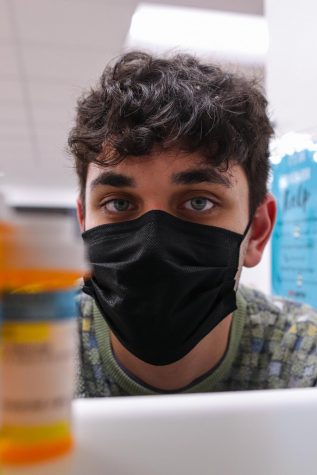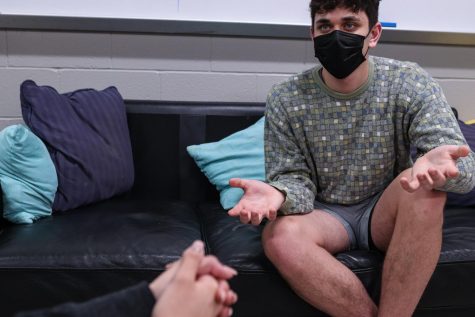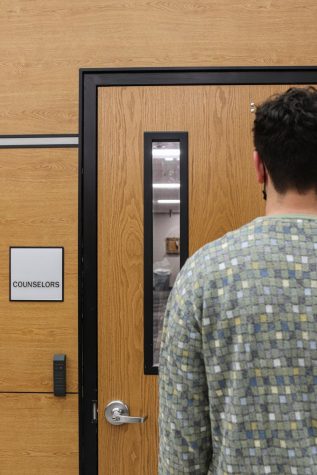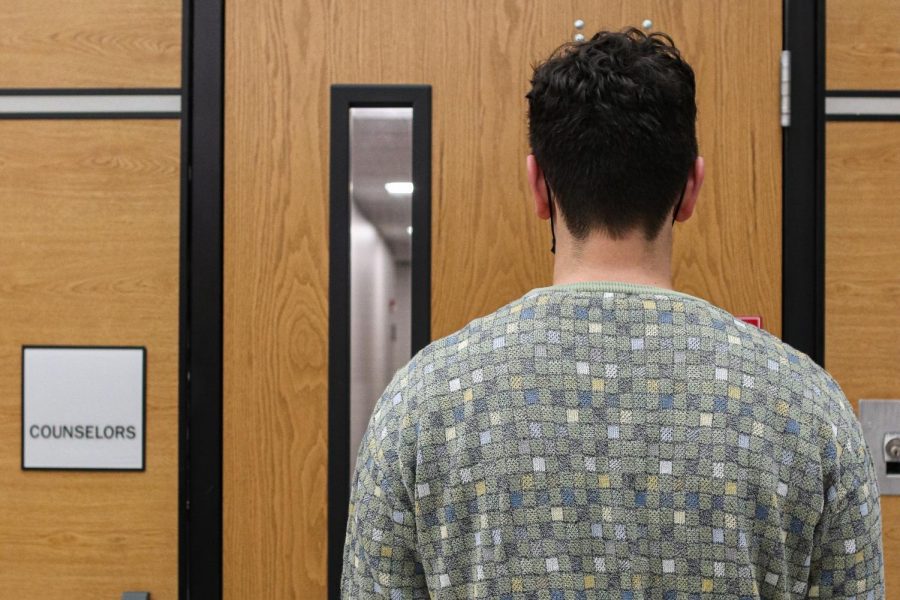Beyond the gradebook
Cracking open Coppell’s experience with mental health
April 6, 2021

Hidden away amongst identical doors behind the staircase in C hallway at Coppell High School is a room with a tightly shut door, almost always locked. Every so often, its light is flicked on but its door remains closed, indicating the crisis counseling service is in use.
THE SHIFT IN FOCUS
“There’s lots of different reasons our [students], or even staff members may need to talk to somebody about the things they are going through in their personal lives,” Coppell ISD assistant superintendent for curriculum and instruction Dr. Angie Applegate said. “That’s the initial reason why we added another crisis counselor [Melissa Caffrey] to Coppell ISD; because we have goals for our district that are focusing on bridging a more holistic experience, with not just the wonderful academic experience, but prioritizing social-emotional learning (SEL) needs.”
Dr. Applegate, who supports campus principals and campus counselors, has directed the district goals to be more mental health focused. This, along with Texas’s growing mental health requirements for school districts, has caused a shift over the past two years.
“A lot of the conversation I was having with our campus administrators, as well as our curriculum team, was thinking about our core values and that fourth core value of redefining success,” Dr. Applegate said. “We started peeling back those layers, and we started setting more specific goals in our district. We’re going to target those areas, as well as look at some of the things that the state of Texas is putting as requirements for districts focused around mental health.”
Another proponent of mental health services at CHS is Principal Laura Springer, whose addition to the school two years ago also helped to bring forward the shift.
“Just as important as academic excellence is mental health,” Springer said. “When I say I want [students] well-rounded, I mean physically and mentally healthy, and we should be providing every opportunity for them to have advocates in this building. We have to start setting up programs and looking at issues that are happening with our kids and giving them an outlet to talk and be heard.”
One of the main areas of focus is destigmatizing mental illness and better advertising the resources available to struggling learners and staff. Still, the process of widening mental health reach is slow.
“I don’t really know anything about Coppell’s mental health system or if they have one, none of my teachers really touch on it,” CHS student Kalani Levitt* said. “I don’t feel like they’ve done much to bring awareness to mental health, and it hurts because I know people who are really struggling with it.”

By embedding SEL into the curriculum, CISD hopes to further educate on the reality of mental illness. At the elementary level, some classes have counseling lessons and allow time to share feelings, but with the shift, CISD plans to more intentionally put in place practices to further its ultimate goal, particularly a comprehensive counseling program from pre-K to senior year to embed mental health conversation into practice.
For example, a high school student in an English class having conversation about a piece of literature would be able to talk through the social emotional needs of a character to encourage introspection. This way, it would not be an extra topic teachers could skip over, nor would it be an extra burden to include in lesson plans.
CISD’s progress with mental health is measured with the Panorama survey, which all learners are required to take, another addition implemented with the shift in 2019. The survey pulls SEL data from staff members, learners and families.
“When we’re thinking about measuring growth as a district, we need to be able to see hard data, and some of that is through the quantitative piece where you’re looking at numbers and scales,” Dr. Applegate said. “We’re beginning to look at feedback that is focused around social emotional health, and that’s where we’ll see how we’re moving ahead with certain skills we’re working on with kids, whether that’s resiliency, whether that’s GRIT, whether that’s self management.”
The data from the survey is shared with the campus leadership team and educators so they can see their students within subgroup areas like GRIT and self management. Another new addition is a system offered to teachers that includes grades, attendances and survey data of students and gives teachers a more holistic view of all their students.
“We really made a shift as a district to start utilizing our current staff to help the support as a whole,” Dr. Applegate said. “Our crisis counselors, along with our campus counselors, have, within the last two years, focused on the training for professional learning we’re providing to our staff as a whole. We have some new requirements this year that are focused on trauma informed care and talking about how we can support kids that may be going through some things in their lives.”
After taking the Panorama survey last year, Levitt was one of many students called in to discuss concerning results and talk about her responses.
“The way [the counselors] were talking about it – brushing past [my results] – made it feel like they didn’t want to talk about it, they just had to,” Levitt said. “It was like a five minute conversation; I didn’t feel comfortable; they didn’t make me feel like they cared. I don’t talk to my counselors like that; they don’t really know me. So whenever I did have those issues, I would go to a teacher I trusted. They know me more as a person, and they could really help me.”
CISD is also working on replacing more outdated resources, particularly those concerning drug and alcohol awareness, and making them similarly further embedded.
“The counselors and I have had conversations about what resources we have, and we are still lacking, especially for secondary campuses, but that’s something we’re working on more,” Dr. Applegate said. “CHS is supposed to be doing Signs of Suicide, similar to the Teen Screen, but it has an education component. It is embedded into the classroom where our crisis counselors and counseling team are going into the classroom to work at the secondary campuses in order to not only have a screener for kids that may have needs, but also to have a more aligned approach to how we’re collecting that data.”

THE PRIMARY RESOURCE: COUNSELING
“At CHS, every learner has a campus counselor who can help them if they are going through a difficult time,” CISD crisis counselor Kelly Spears said. “We also have crisis counselors who collaborate and partner with campus staff support to learners who might benefit from having an additional person to talk to.”
Within Texas, counselors hold certifications, as well as master’s degrees in either school or professional counseling, while crisis counselors are required to have an additional crisis counseling license. Access to trained counselors is the primary resource CISD offers for its students’ and staff’s mental health.
“When we get our licenses, it’s a broad range for counseling,” CHS lead counselor Ann Cinelli said. “We have three crisis counselors [Tanya Berent, Caffrey and Spears] who are our leaders with mental health counseling because our focus as counselors was not designed for that. They help us be great mental health counselors through consultation, and they directly meet with students who have those strong needs. They are the driving force behind mental health in the district.”
Although counselors are trained to deal more specifically with mental health of learners, Spears encourages learners to go to any trusted adult at CHS they feel comfortable with to talk if necessary.
“Finding those kinds of people is vitally important,” Springer said. “Anytime I hire a teacher for a school, I’m looking at several things. Number one, I’m looking for teachers that meet the needs of our students not just in the classroom with the content, but will also be a person I feel our kids would talk to if they’re having problems and go to if they needed advice. They would be an ear for teenagers’ problems with friends and dating and other relationships.”
Campus counselors work to develop relationships with learners and offer check-ins on mental health goals and progress, as well as talking to teachers about the learner’s situation, so they can keep the situation in mind during high stress units and lessons.
“A lot of times, it’s stress or anxiety, parents or classes and things going on outside of school, definitely a lot of anxiety about graduating, being a teenager and having relationships with peers [that brings learners to us],” Cinelli said. “We work to find some of the things that students can do outside of school, finding that no stress time and what destresses someone and think about how we can use those to help learners. Every student is different, and it’s about finding what relieves them. When I first started four years ago, anything mental health always went to our crisis counselor, but we’ve grown into being able to provide mental health counseling on our own.”
Campus counselors also make themselves available in any form of communication, offering a space to share in email and by phone to ease the stress of seeing a counselor in-person. When necessary, campus counselors will reach out to crisis counselors for additional consultation.
“There’s not a one size fits all when defining ‘this is a crisis, this isn’t a crisis,’” Spears said. “Every situation is unique to the individual and we want to address it as such. If a learner feels like they need some additional support, we encourage them to reach out to someone to see how we can get them the help or resources they need.”
According to Spears, neither type of counselor is able to provide mental health treatment or determine when a student requires therapy.
“They don’t really know what to do if it’s not academically involved,” CHS student Briar Jones* said. “The crisis counselor basically assesses threat levels; they’re not very good at talking you out of things. It’s not what’s expected of them; they’re not trained for that. The crisis counselor, I know she’s trying her best; she’s a sweet lady, and I know the counselors are trying their best, but there’s only so much they can do.”
This, according to Jones, serves as one of the biggest obstacles to students receiving help for mental health at school.
“In a school setting, our role is not to provide mental health treatment; however, we do work with learners individually to establish healthy goals, mindsets, and behaviors,” Spears said. “If a learner or family feels they would benefit from mental health treatment, we can assist with navigating potential next steps or identifying available resources in the community.”
When a learner informs a counselor or staff member at the school that they are a danger to themselves or others, the staff is required by law to report this to parents. Jones went to a counselor during their freshman year to address the intense feelings they had been dealing with for some years. According to Jones, when talking to the counselor, they were asked some questions about their home life, then the crisis counselor was called promptly. Soon after, Jones’s parents were called as well.
“It was effective for me, but I don’t think it’s an effective system in general,” Jones said. “It was an issue I’d had at first. My dad was nervous about having me seek out professional help; it made him feel like something would go wrong. For a long time after I’d reached out to a counselor, nothing really happened. It kind of made it worse. For a lot of kids, it makes things worse, to the point where they feel like they can’t reach out to counselors. ”
Though some students do not feel comfortable reaching out because of the parental restrictions, many do feel comfortable reaching out about subjects that do not deal with harm. Thus, in order to get help in situations that involve harm to oneself or others, learners often seek other resources outside of the community, such as hotlines. After having a conversation with the counselors due to her Panorama results, Levitt looked into outside resources that could help her with her mental health in the future.
“One day, my parents divorce was weighing on me, and I had three tests, and I really just wasn’t being myself,” Levitt said. “My teacher asked if I wanted to go to the counselor, and he really talked me down. He really did help and put it into perspective. The counselors are helpful for certain things, but they draw the line once kids start talking about darker things; I know the school thinks they’re helping, but it can hurt students.”
The counselors also provide access to a list for mental health resources outside of school, including hotlines and counseling opportunities. According to Springer, the school compiles this list of resources, including contacts for youth ministers from various faiths, psychiatrists and support groups through active contact with parents whose children have used their help.
Cinelli, in return, poses that such situations that pertain to self harm or harm others have a need for urgency. Across the nation, counselors are required to report self harm or possible harm to others.
“I get the legality of it as a counselor and as a mom, I would want to know what my daughter was going through,” Cinelli said. “But seeing it first hand from high school kids, I understand why they wouldn’t want that. We make it happen, we just do it, but sometimes I wish we could say, ‘We’ll call mom by the end of the month and we work up to that,’ whereas for safety reasons, it’s an immediate thing. I do get that the restraint can be tough.”
Through their years at CHS, the counselors would check in with Jones, and after speaking to a crisis counselor about their suicidal ideations, the school informed Jones’s parents they needed to be hospitalized.
“It was a good thing that they kept track because if I had slipped through the system, things probably would have gotten a lot worse for me,” Jones said. “Sometimes, they are not able to do enough, and it’s not entirely their fault. They’re bound up legally. They can’t hear that a student wants to hurt themselves or someone else without having to tell that kids’ parents. It’s not a reflection of CISD; it’s a reflection of the national mental health system as a whole.”
Even so, CISD is working towards easing its environment to make a less stressful situation that decreases some of the causes of mental health in its schools.
“When we’re thinking about ‘redefining success’ as you don’t have to be the best at everything, you can also have growth,” Dr. Applegate said. “That’s an area we’re still working on; it’s not all about a number grade, and it’s not all about having to be the best at everything, it’s finding the strengths we have in everyone.”
Follow Anjali (@anjalikrishna_) and @CHSCampusNews on Twitter.
*Disclaimer: Names marked with an asterisk represent CHS students who preferred to remain anonymous.
** Photos are staged with a model.

